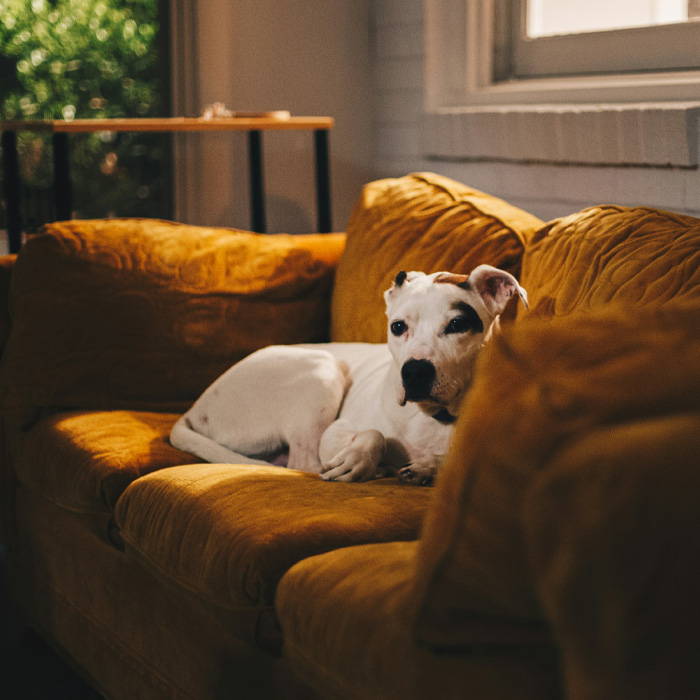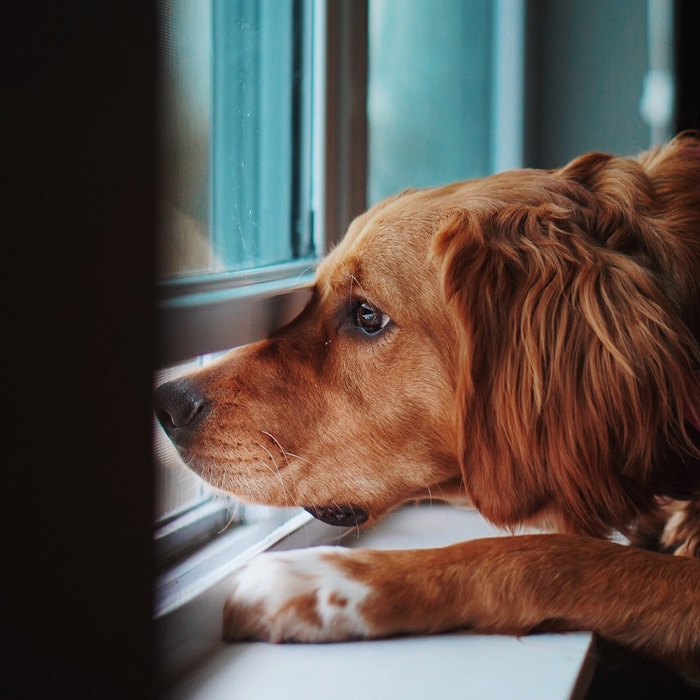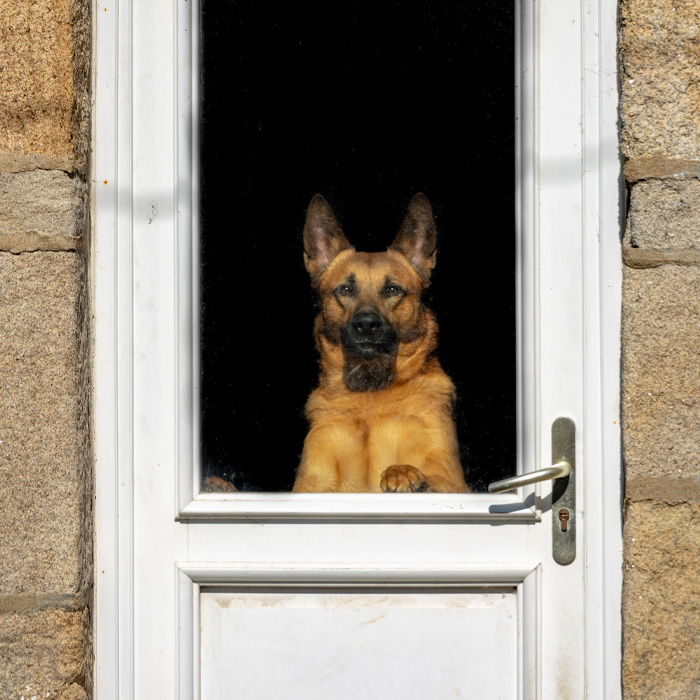Knowing a dog’s life, especially when they’re alone at home, is vital for any dog owner– it’s not just about their physical health, but also about understanding their emotional and mental state. When we head off for work or other activities, our dogs start their day, filled with unique routines and behaviors.
This article explores the common activities and habits of dogs when left on their own, shedding light on their world when we’re not around.
- Dogs sleep 12-14 hours daily in short and long naps.
- Common activities include playing with toys and exploring.
- Separation anxiety in dogs can lead to destructive behavior.
The information provided herein is for informational purposes only. Please refer to our disclaimer for more details..
Understanding a Dog’s Daily Schedule
Image source: Hayes Potter
Exploring a dog’s daily routine shows a pattern – this varies among different breeds and individual dogs – but typically balances rest, play, nutrition, and exercise. Knowing these aspects is key to a dog’s overall well-being and happiness.
Typical Daily Routine for a Dog
A dog’s day typically begins with waking up and heading off for a morning walk – this isn’t just for a bathroom break but also for physical exercise and mental stimulation. Following the walk, they usually have their first meal. Post-breakfast, many dogs take a morning nap, often when their human friends leave for work.
In the midday, dogs often engage in more activities – they might wake up, play with their toys, or wander around the house. If they have a yard, this time could include outdoor play. The afternoon often brings another quiet period, leading to more resting or napping.
As evening approaches and the household stirs back to life, dogs often become more alert – they might go for another walk, play with their family, and eat their dinner. The evening is generally a more active and social time for dogs – this includes playing, training, or simply relaxing with family members. Before bedtime, a quick walk or bathroom break is typical, and then they settle down for the night.
Average Sleep Duration and Patterns
Dogs, typically, sleep for 12 to 14 hours daily–but it can vary. Puppies, larger breeds, and older dogs often need more rest, sometimes as much as 18 hours. Unlike humans, dogs don’t sleep in one long stretch. Instead, they have a polyphasic sleep pattern–meaning they take several naps over 24 hours. Their sleep is influenced by many factors, including their environment and their age.
Also, their activity level and the daily routines set by their human companions affect how much they sleep. This mix of short and long naps helps them stay alert and active when awake.
Regular Eating and Exercise Schedules
For dogs, having a regular schedule for eating and exercising is key. Adult dogs usually thrive on two meals a day, but puppies often need more–due to their rapid growth. Setting meals at consistent times helps regulate their internal clock and supports good digestion.
Exercise needs differ greatly among dog breeds, but all dogs gain from regular physical activity. Activities like daily walks, playful sessions, and training exercises are actually crucial–not just for their physical health but also for mental sharpness. Regular physical activity also wards off boredom and the behavioral problems that can follow.
Importance of Consistency in a Dog’s Daily Routine
Sticking to a routine is crucial for dogs–it gives them a feeling of safety and helps them know what comes next. This predictability lessens their anxiety and stress. A consistent daily schedule of meals, walks, play, and rest is key–it tunes their internal clock and greatly affects their mood and behavior.
When their routine is inconsistent, dogs can get confused and stressed, which might lead to behavior problems. Keeping a routine ensures they stay happy and well-behaved.
Activities and Behaviors of Dogs When Alone
Image source: Mark Zamora
When our beloved dogs are left alone, their day is filled with a mix of activities and behaviors. Knowing these helps us ensure they’re not just safe and comfy but also happy and busy.
Common Activities Dogs Engage in When Left Alone
When left alone, dogs engage in a few common activities:
- Sleeping and Resting: Dogs often spend much of their alone time sleeping or just resting—conserving energy as their wild ancestors did.
- Playing with Toys: Dogs also find fun in toys. They particularly like chew toys, treat-dispensing ones, and puzzle toys, which offer both mental and physical exercise.
- Looking Out the Window: Many dogs enjoy peering out the window—watching the busy world outside. This gives them visual excitement and keeps them connected to the outside world.
- Exploring the House: Dogs often roam around the house, sniffing and investigating different areas. This wandering satisfies their innate curiosity and also provides essential mental stimulation.
Behavioral Changes: How Dogs Behave Differently in the Absence of Their Owner
Dogs can exhibit a range of behaviors when their owner is not around:
- Increased Vocalization: Some dogs might bark, whine, or howl more when alone—a sign they might be distressed or just expressing themselves.
- Decreased Activity: In the absence of their human friends, some dogs tend to be less active, preferring to sleep or rest more.
- Hiding or Seeking Comfort: Dogs often look for comfort in a familiar place, like their bed or a beloved blanket, especially if they’re feeling anxious.
- Increased Vocalization: Some dogs might bark, whine, or howl more when alone—a sign they might be distressed or just expressing themselves.
- Decreased Activity: In the absence of their human friends, some dogs tend to be less active, preferring to sleep or rest more.
- Hiding or Seeking Comfort: Dogs often look for comfort in a familiar place, like their bed or a beloved blanket, especially if they’re feeling anxious.
Exploration and Interaction with the Home Environment
Dogs engage with their environment in many ways:
- Sniffing and Exploring: With their sharp sense of smell, dogs actively sniff around—using this ability to understand their surroundings. They often investigate new or interesting scents.
- Adjusting Their Space: Dogs may rearrange their space, shifting bedding or toys. This behavior reflects their comfort and territorial instincts.
- Interacting with Household Items: Often, dogs play with household items. They might chew or scratch, especially if they lack toys or feel anxious—this can be both playful and problematic.
Signs of Separation Anxiety and How to Address Them
Image source: Sébastien Goldberg
Separation anxiety is a frequent problem in dogs, marked by distress and misbehavior when they’re alone. Key signs include:
- Destructive Actions: Engaging in damaging behaviors—like chewing, digging, or scratching at doors and windows.
- Loud Noises: Dogs may exhibit persistent barking, howling, or whining—these sounds are a clear sign of their anxiety.
- House Soiling: Unusual incidents of urinating or defecating indoors, especially if it’s not typical for the dog.
- Unsettled Movements: Showing restlessness and pacing, often near windows or doors—indicating their discomfort at being alone.
Addressing separation anxiety in dogs involves various strategies:
- Safe Haven Creation: Setting up a cozy spot—like a crate or a quiet corner with their bed and toys—can make dogs feel secure.
- Gradual Alone Time: Slowly getting your dog used to being alone for short periods, and then increasing the time, can help them adapt.
- Brain Games: Offering enough mental challenges through toys, puzzles, or scent games keeps their minds engaged.
- Regular Exercise: Ensuring your dog gets enough physical activity can reduce their stress and anxiety levels.
- Seeking Expert Advice: In every extreme case, it’s wise to consult a veterinarian or a professional dog behaviorist.
Tips to Follow for Dog Care and Well-Being
Creating a Comfortable & Stimulating Environment: Make sure a safe space for your dog, with cozy bedding, accessible water, and toys. Add items with familiar scents for comfort. Allow them to look out windows for stimulation, but be cautious of overstimulation. You can also give them treats.
Exercise & Managing Anxiety: Try to match exercise activities to your dog’s breed and age, using indoor options when necessary. Observe and respond to signs of anxiety by maintaining a consistent and predictable environment for your dog.
Monitoring & Adjusting: Use modern technology to watch your dog’s behavior and body language—regularly change your methods to suit their changing needs and likes.
Preparing for Time Apart: Slowly get your dog used to being alone. If you’ll be away longer, think about a pet sitter or daycare. When you come home after a day long, re-establish your routine to show them security and love.
FAQs on What Do Dogs Do All Day
Do dogs enjoy doing nothing all day?
Not exactly. Dogs don’t naturally find joy in idleness. While they need rest, they also crave mental and physical activity. Like humans, dogs can get bored and restless without things to do. To keep them happy and healthy, it’s vital to balance their day – with rest, play, exercise, and mental stimulation.
Do dogs get bored sitting all day?
Dogs can become bored if they’re left sitting all day without any activities or mental stimulation. Boredom in dogs can lead to problems – like destructive behavior, anxiety, and even depression. Dogs are intelligent beings, and to keep them happy and healthy, they require regular physical exercise, mental challenges, and social interaction.
What are dogs meant to do all day?
Dogs are naturally active and sociable creatures. Their daily routine should include a mix of activities that address their physical, mental, and social needs. This encompasses playtime, exercise, exploration, training, and bonding with humans or other dogs. Rest is also crucial.
2Kviews
Share on Facebook
















0
0